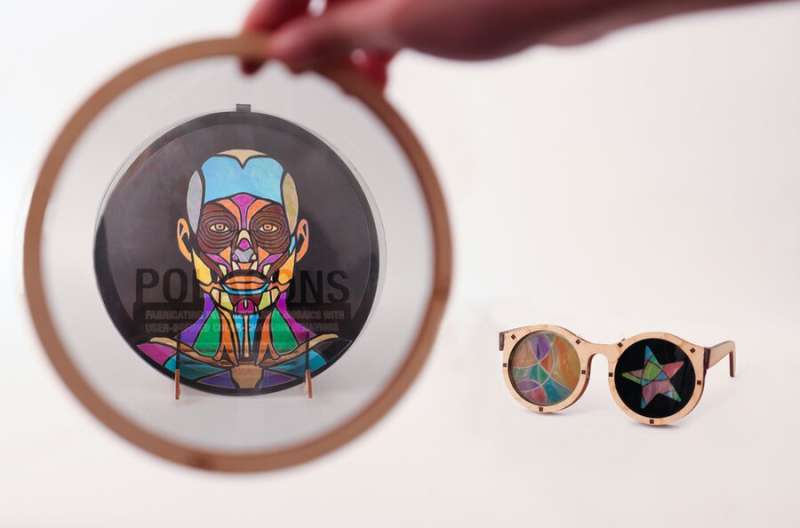This article has been reviewed according to Science X's editorial process and policies. Editors have highlighted the following attributes while ensuring the content's credibility:
fact-checked
trusted source
proofread
A design tool to democratize the art of color-changing mosaics

A colorful new design tool developed by MIT researchers allows individuals to create polarized light mosaics that can be printed on cellophane to make data visualizations, passive light displays, mechanical animations, fashion accessories, educational science and design tools, and more.
Ticha Melody Sethapakdi, a Ph.D. student in electrical engineering and computer science and affiliate of the MIT Computer Science and Artificial Intelligence Laboratory (CSAIL), is leading the use of regenerated cellulose to make what she calls Polagons, machine-made color-changing mosaics that use polarized light to inform and delight. Such polarized light mosaics have previously been crafted by hand, and Sethapakdi was inspired by artists such as Austine Wood Comarow, whose innovative "polage art" is based on the same physics principles. The new computational Polagon design system, however, enables a fabrication process based on laser cutting and welding, all with minimal assembly by the user.
Users first import custom mosaic designs, and the system computes the feasible color palette given a user's cellophane supply. Uploading multiple designs to the interface allows users to create "morphing" mosaics that can transition from one image to another. Then, it's on to logistics: Polagons optimizes the necessary constituent components for each scenario, like the type and number of sheets needed. Once the user finishes uploading designs, playing around with colors, and visualizing the color-changing behaviors, they can export the fabrication files and chop them up in a laser cutter.
What's so special about cellophane, anyway? The sheets have a property called birefringence, meaning that when light passes through, the speed of light is different depending on the propagation angle. When the sheets get put into a "sandwich" of two polarizers (material that only lets certain polarities of light pass through while blocking others), they appear colored. The colors you see depend on different factors in the material, like thickness and the angle of the material relative to the two polarizers. To create that color-changing effect, you just need to rotate the image, or the polarizers, because then you're changing the angle of light propagation.
"Perhaps, in the future, since these designs are non-electronic, they could enable interesting underwater applications, where you put these types of mosaics in places that might be difficult for electronics to stay in. That's what's special here, that all of these color-changing effects are mechanical," says Sethapakdi.
One limitation of Polagons is the inability to represent every color on the rainbow in a continuous way. The team believes a potential solution could be changing the fabrication process to support a constant mode of building colors. This might mean 3D-printing a birefringent material to access a more extensive palette and have more control over the colors.
"In creating this system, I was mostly interested in democratizing this art form and helping preserve something that might only be accessible to skilled individuals. If something happens to the creator of this layering principle, Austine Wood Comarow's family, does the art then die with them? If we didn't have some way of preserving that or continuing it, then you would lose something that would be very precious to the world," says Sethapakdi. "I think there is a real benefit to building these systems that democratize niche art forms. We hope this tool can expand the community of modern polarized light mosaicists. Since we are making this process accessible to a larger group of users, it can add new programmable material to the palette of options in [human-computer interaction]."
Sethapakdi and her team will present their research at the 2023 Conference on Human Factors in Computing Systems (CHI 2023).
More information:
Ticha Sethapakdi et al, Polagons: Designing and Fabricating Polarized Light Mosaics
with User-Defined Color-Changing Behaviors (2023). DOI: 10.1145/3544548.3580639




















